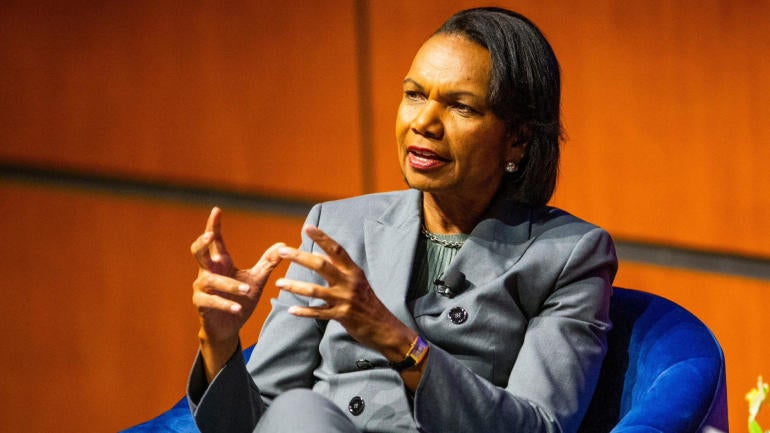
Stanford, Cal and SMU tapping some powerful allies in their bid to join the ACC. Former Secretary of State Condoleezza Rice, on Stanford's behalf, and former President George W. Bush, for SMU, have been in contact with officials around the ACC in a bid to get those respective schools into the league, Yahoo Sports reports.
The ongoing negotiations include Cal, though it is without its own representative for the time being. Rice, who served under Bush, is a professor at Stanford. She is also the director of the school's Hoover Institution, an American public policy research center.
Bush's wife, Laura, graduated from SMU. The school also boasts the George W. Bush Presidential Center, which contains his presidential library and museum. Bush was raised in Texas, served as the Governor of Texas and moved to Dallas when his presidency came to an end in 2009.
Stanford and Cal are searching for new homes after their current conference, the Pac-12, lost eight members over the last year. SMU has long lobbied for inclusion in a power conference and showed interest in the Pac-12 before its dissolution.
In order to start the process, 12 of the ACC's member institutions (including Notre Dame) need to support extending invitations. In a recent straw poll conducted by the ACC's universities, the expansion agenda failed to receive enough support. Reports indicated that Florida State, Clemson, NC State and North Carolina were opposed.
Money a sticking point
As Yahoo Sports points out, and as most can surmise, money is at the heart of the issue. Stanford has one of the nation's deepest endowments, while SMU has a strong booster pool that is ready and willing to financially support all the aspects of a move.
Additionally, the ACC's television contract with ESPN dictates that the network increases the value of the deal for each additional member, according to Yahoo Sports. If Stanford and SMU join, they can afford to forego their shares for a time, allowing other schools in the ACC to benefit monetarily.
However, Cal's athletic department is in debt and any sort of television revenue would be a much-needed lifeline, especially since the institution will be without a conference in less than a year. That adds baggage an otherwise-streamlined decision.
Where else can Stanford, Cal go?
Given Stanford's overall athletics success and standing as a top academic institution, it is the most appealing candidate among those schools actively searching for a new conference. Stanford could afford to go independent if none of its other options work out.
Cal certainly cannot, though. It could spearhead a Pac-12 rebuilding effort, but that would be difficult if Stanford is not willing to hitch its wagon to that. The Mountain West Conference and the AAC remain realistic possibilities for Cal.
As for SMU, it already has a solid home in the AAC, arguably the best non-power conference over the past few years. Though the Mustangs are riding the wave of expansion right now, they could afford to wait and improve their standing with successful on-field performances.
The rest of the Pac-12 leftovers
Stanford and Cal are not the only Pac-12 programs scrambling for a new future. Oregon State and Washington State, thus far, have been left out of any solid expansion conversations.
Neither boasts a robust and appealing market size -- even though Oregon State just poured $161 million into renovating its stadium and facilities. The Beavers are coming off a 10-win season and should factor into the Pac-12 race this year.
But the Big Ten already hit both areas with the addition of Washington and Oregon. The Big 12 is set to add three Pac-12 schools that will give it a foothold near the West Coast, and the SEC hasn't shown any interest in any Pac-12 programs. The ACC's aversion is obvious.
Washington State and Oregon State's most likely path to a new conference lies in either the Mountain West or the AAC. Both would be an obvious step down in standing, but it at least means stability.
![[object Object] Logo](https://sportshub.cbsistatic.com/i/2020/04/22/e9ceb731-8b3f-4c60-98fe-090ab66a2997/screen-shot-2020-04-22-at-11-04-56-am.png)
















